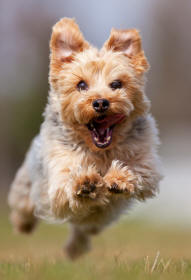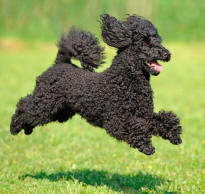Glossary

Gait
The pattern of movement of animals during (terrestrial) locomotion.
Gaits used by cats and dogs include the walk, the amble, the pace, the trot, the canter and the gallop.
Gaits used by cats and dogs include the walk, the amble, the pace, the trot, the canter and the gallop.
Suspension Phase
A phase of a gait when all four feet are off the ground.


Trot
A symmetrical, two-beat gait in which diagonally contralateral limbs move in unison.
This is an endurance gait, which allows coverage of ground at a reasonable speed but without expending maximum energy. The trot may, therefore, be maintained for hours.
This is an endurance gait, which allows coverage of ground at a reasonable speed but without expending maximum energy. The trot may, therefore, be maintained for hours.
Suspended Gallop
This is a four-beat gait, at which an animal reaches its fastest speeds.
The suspended gallop has suspension phases (when no feet are in contact with the ground).
There are two varieties of the suspended gallop: the single suspension gallop and the double suspension gallop.
The suspended gallop has suspension phases (when no feet are in contact with the ground).
There are two varieties of the suspended gallop: the single suspension gallop and the double suspension gallop.
Supported Gallop
A gallop in which at least one limb in on the ground at any one time.
This is more usually known as a canter, and is contrasted with the suspended (full) gallop.
This is more usually known as a canter, and is contrasted with the suspended (full) gallop.
Single Suspension Gallop
An asymmetrical, four-beat gait, in which there is just one suspension phase, which occurs when all four limbs are airborne, gathered under the body.
All four limbs contact the ground separately, none in unison.
All four limbs contact the ground separately, none in unison.
Ipsilateral
Relating to the same side of the body.
For example, ipsilateral limbs are limbs that are on the same side of the body.
For example, ipsilateral limbs are limbs that are on the same side of the body.
Contralateral
Relating to the opposite side of the body.
For example, diagonally contralateral limbs are limbs on diagonally opposite sides of the body.
For example, diagonally contralateral limbs are limbs on diagonally opposite sides of the body.
Double Suspension Gallop
An asymmetrical, four-beat, “leaping” gait in which there are two suspension phases.
In the first suspension phase, forelimbs are fully extended forwards while the hind limbs extend backwards.
In the second suspension phase both fore- and hind limbs are gathered (airborne) under the body.
In the first suspension phase, forelimbs are fully extended forwards while the hind limbs extend backwards.
In the second suspension phase both fore- and hind limbs are gathered (airborne) under the body.





